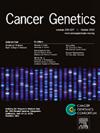Acute cardiac dysfunction in patients with ovarian cancer treated with Niraparib due to TFAM mutation: A case series and functional analysis
IF 2.1
4区 医学
Q4 GENETICS & HEREDITY
引用次数: 0
Abstract
Background
Ovarian cancer is a leading cause of gynecological cancer mortality. Despite Niraparib's efficacy in increasing progression-free survival for recurrent ovarian cancer, its potential cardiotoxic effects are underexplored.
Objective
We performed a case series analysis involving two postmenopausal sisters who developed heart failure subsequent to Niraparib therapy for recurrent ovarian cancer.
Methods
Utilizing targeted next-generation sequencing (NGS), we identified a novel missense mutation c.98T>A in Mitochondrial Transcription Factor A (TFAM) gene, which was subsequently confirmed by Sanger sequencing. To investigate the cardiotoxic effects of Niraparib, we generated human induced pluripotent stem cell-derived cardiomyocytes (hiPSC![]() CMs) carrying the identified mutation. The impact of the mutation on gene expression and protein levels was evaluated through real-time PCR and Western blot analyses.
CMs) carrying the identified mutation. The impact of the mutation on gene expression and protein levels was evaluated through real-time PCR and Western blot analyses.
Results
Two postmenopausal sisters treated with Niraparib suffered significant cardiac dysfunction. NGS identified a novel c.98T>A variant in TFAM gene, resulting in a missense mutation. HEK293T cells transfected with mutant plasmids demonstrated normal expression of full-length TFAM mRNA and protein. hiPSC![]() CMs model revealed the variant alone did not induce cardiomyopathy. However, it predisposed to Niraparib-induced cardiomyopathy-like toxicity, mediated by metabolic dysregulation and increased cellular apoptosis
CMs model revealed the variant alone did not induce cardiomyopathy. However, it predisposed to Niraparib-induced cardiomyopathy-like toxicity, mediated by metabolic dysregulation and increased cellular apoptosis
Conclusion
Our study revealed a novel TFAM variant which might induce potential cardiovascular toxicity of anticancer Niraparib therapies.
因TFAM突变而接受尼拉帕尼治疗的卵巢癌患者的急性心功能障碍:病例系列和功能分析
卵巢癌是妇科癌症死亡的主要原因。尽管Niraparib在提高复发性卵巢癌的无进展生存期方面有效,但其潜在的心脏毒性作用尚未得到充分研究。目的:我们对两名绝经后的姐妹进行了病例系列分析,她们在接受尼拉帕尼治疗复发性卵巢癌后出现心力衰竭。方法利用靶向新一代测序(NGS)技术,在线粒体转录因子a (TFAM)基因中发现了一个新的错义突变c.98T> a,并通过Sanger测序进行了验证。为了研究尼拉帕尼的心脏毒性作用,我们生成了携带该突变的人诱导多能干细胞衍生的心肌细胞(hiPSCCMs)。通过实时PCR和Western blot分析评估突变对基因表达和蛋白水平的影响。结果2例绝经后姐妹接受尼拉帕尼治疗后出现明显心功能障碍。NGS在TFAM基因中发现了一种新的c.98T>; a变异,导致错义突变。转染突变质粒的HEK293T细胞显示全长TFAM mRNA和蛋白的正常表达。hiPSCCMs模型显示,该变体本身不会诱发心肌病。然而,它更倾向于由代谢失调和细胞凋亡增加介导的尼拉帕尼诱导的心肌病样毒性。结论:我们的研究揭示了一种新的TFAM变异,它可能诱导抗尼拉帕尼治疗的潜在心血管毒性。
本文章由计算机程序翻译,如有差异,请以英文原文为准。
求助全文
约1分钟内获得全文
求助全文
来源期刊

Cancer Genetics
ONCOLOGY-GENETICS & HEREDITY
CiteScore
3.20
自引率
5.30%
发文量
167
审稿时长
27 days
期刊介绍:
The aim of Cancer Genetics is to publish high quality scientific papers on the cellular, genetic and molecular aspects of cancer, including cancer predisposition and clinical diagnostic applications. Specific areas of interest include descriptions of new chromosomal, molecular or epigenetic alterations in benign and malignant diseases; novel laboratory approaches for identification and characterization of chromosomal rearrangements or genomic alterations in cancer cells; correlation of genetic changes with pathology and clinical presentation; and the molecular genetics of cancer predisposition. To reach a basic science and clinical multidisciplinary audience, we welcome original full-length articles, reviews, meeting summaries, brief reports, and letters to the editor.
 求助内容:
求助内容: 应助结果提醒方式:
应助结果提醒方式:


